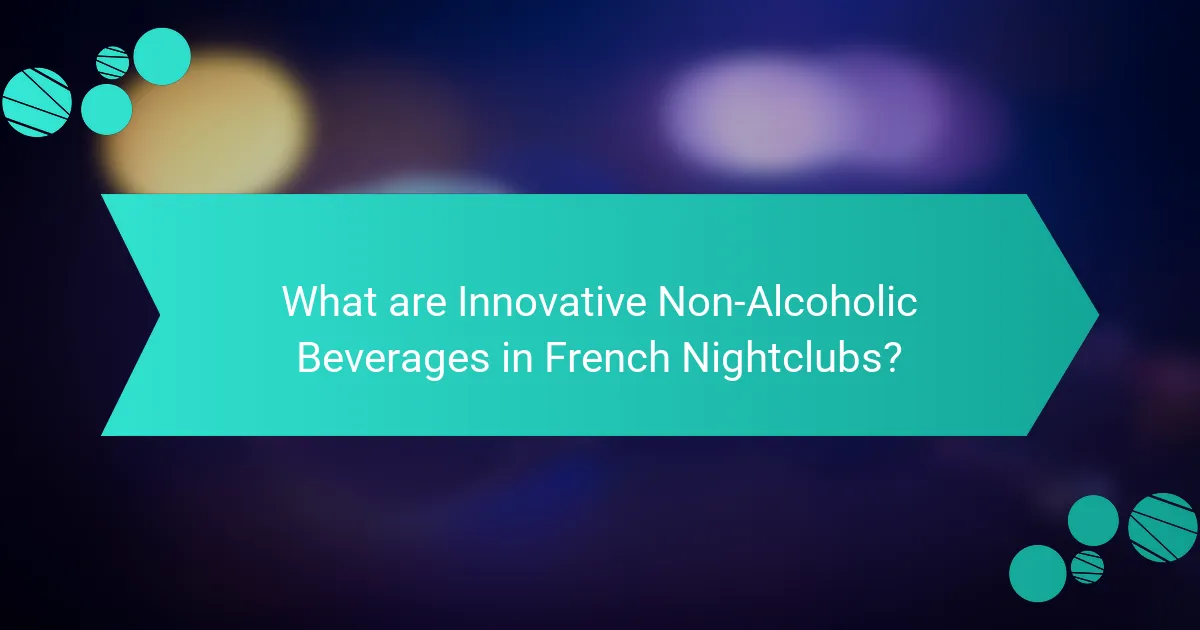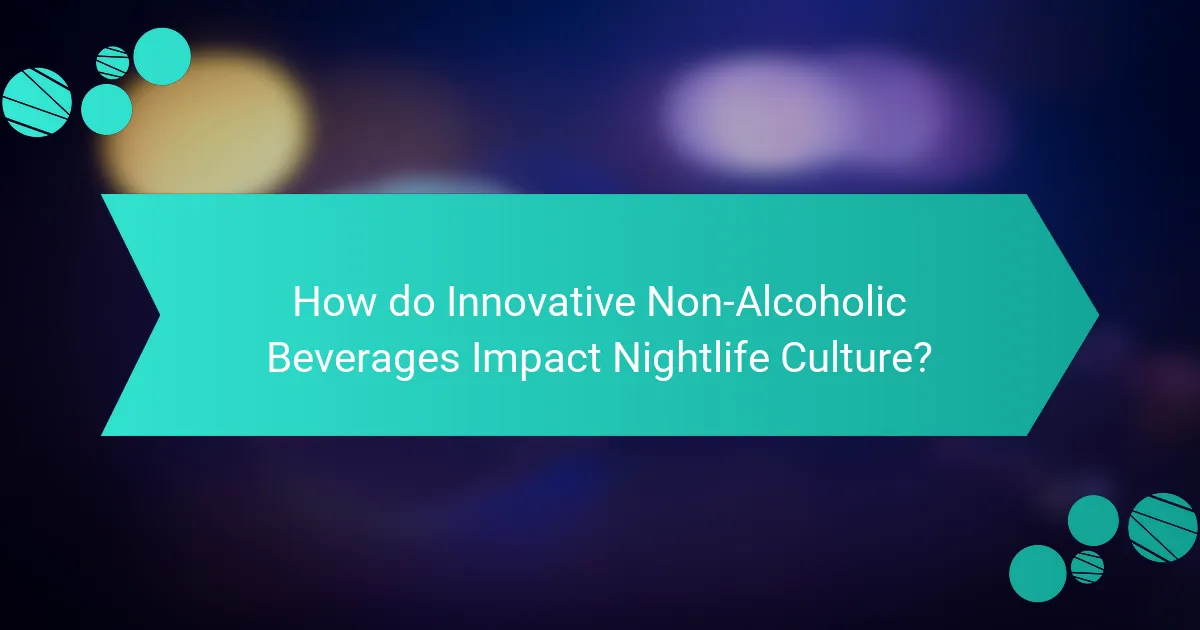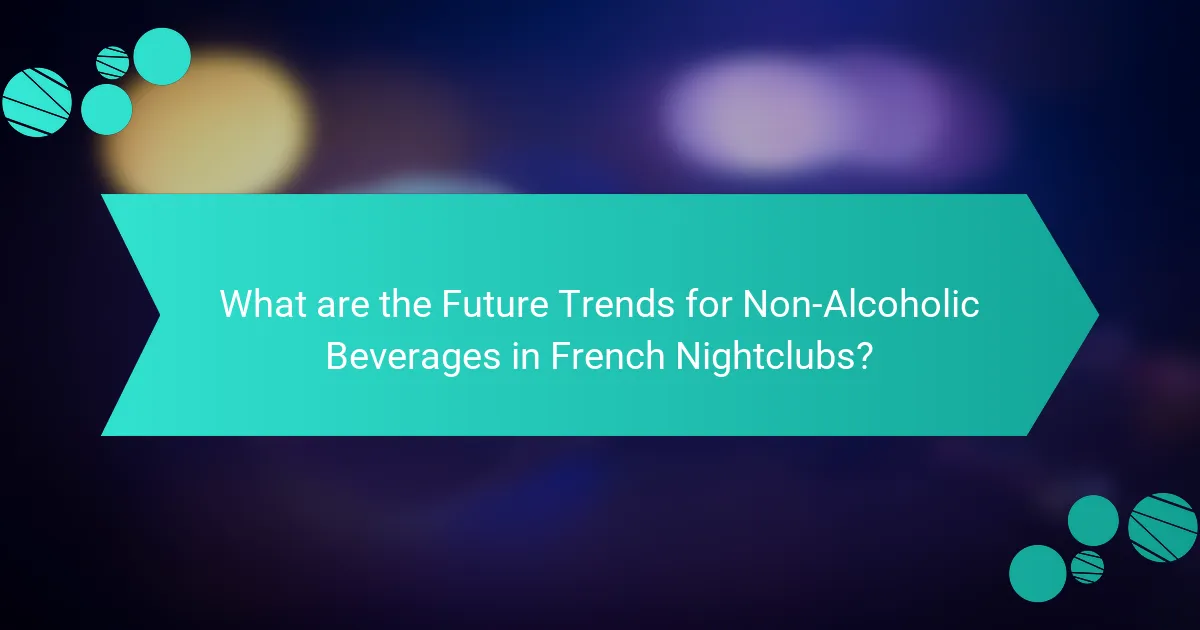Innovative non-alcoholic beverages in French nightclubs encompass a range of creative mocktails and artisanal sodas, featuring unique flavor combinations such as basil with watermelon and lavender with lemon. The presentation of these drinks is crucial, often served in stylish glassware and garnished with fresh herbs or edible flowers. The growing popularity of these beverages reflects a shift towards inclusivity and health-conscious choices in nightlife, particularly among younger patrons. Research indicates a 30% increase in demand for non-alcoholic options, highlighting a cultural trend that prioritizes moderation and wellness while enhancing social experiences in nightlife venues. Future trends suggest an emphasis on craft mocktails, exotic ingredients, and visually appealing presentations.

What are Innovative Non-Alcoholic Beverages in French Nightclubs?
Innovative non-alcoholic beverages in French nightclubs include a variety of creative mocktails and artisanal sodas. These drinks often incorporate unique flavor combinations such as basil and watermelon or lavender and lemon. Presentation plays a key role, with drinks served in stylish glassware and garnished with fresh herbs or edible flowers. Popularity has surged for these beverages, especially among younger patrons seeking alternatives to traditional cocktails. Many clubs now feature dedicated non-alcoholic menus highlighting these options. The trend reflects a broader movement towards inclusivity and health-conscious choices in nightlife.
How have non-alcoholic beverages evolved in the nightclub scene?
Non-alcoholic beverages in the nightclub scene have significantly evolved to cater to a growing demand for inclusivity and variety. Nightclubs now offer a diverse range of non-alcoholic options, including sophisticated mocktails and artisanal sodas. This shift reflects a broader trend towards health-conscious choices among patrons. According to a 2022 study by the International Journal of Hospitality Management, 30% of club-goers prefer non-alcoholic drinks. Additionally, innovative flavor combinations and appealing presentations have become essential to attract customers. Many venues now hire mixologists to craft unique non-alcoholic drinks that resemble traditional cocktails in complexity and presentation. This evolution enhances the overall nightlife experience while accommodating those who choose not to consume alcohol.
What factors have contributed to the rise of non-alcoholic options?
The rise of non-alcoholic options is driven by various factors. Increasing health consciousness among consumers has led to a demand for healthier alternatives. A significant trend is the growing awareness of the negative effects of alcohol on health. Many individuals are opting for non-alcoholic beverages to avoid these health risks. Additionally, social media influences have popularized non-alcoholic drinks as trendy choices. Innovative flavor combinations and presentations have made these beverages appealing. The rise in sober-curious culture has encouraged experimentation with non-alcoholic options. Market research indicates a substantial increase in sales of non-alcoholic beverages in recent years. This shift reflects changing consumer preferences and lifestyle choices.
How do these beverages cater to diverse customer preferences?
Innovative non-alcoholic beverages at French nightclubs cater to diverse customer preferences by offering a variety of flavors and presentations. These beverages include unique combinations of fruits, herbs, and spices to appeal to different taste profiles. For example, some drinks feature citrus flavors for freshness, while others incorporate sweet or spicy elements.
Additionally, the presentation of these beverages is visually appealing, often utilizing creative garnishes and stylish glassware. This enhances the overall drinking experience and attracts customers who appreciate aesthetics.
Furthermore, many establishments provide customizable options, allowing patrons to choose ingredients based on personal preferences. This flexibility accommodates dietary restrictions and individual tastes.
Research shows that 70% of consumers prefer beverages that offer unique flavor experiences. This trend indicates that innovative non-alcoholic options are increasingly popular among diverse clientele.
What are the key flavor combinations found in these beverages?
Key flavor combinations in innovative non-alcoholic beverages at French nightclubs include citrus and herbs, such as lemon and basil. Another popular combination is berry and mint, offering a refreshing taste. Tropical fruits like pineapple paired with coconut create a vibrant flavor profile. Spicy elements, such as ginger with lime, add complexity to the drinks. Additionally, floral notes like elderflower with cucumber provide a unique twist. These combinations cater to diverse palates and enhance the overall drinking experience.
Which ingredients are commonly used to create unique flavors?
Common ingredients used to create unique flavors in non-alcoholic beverages include herbs, spices, fruits, and botanicals. Herbs like basil and mint provide freshness. Spices such as cinnamon and cardamom add warmth and complexity. Fruits like passion fruit and pomegranate contribute sweetness and acidity. Botanicals, including elderflower and hibiscus, offer floral notes. Combining these ingredients enhances depth and creates memorable taste experiences. Research shows that innovative flavor combinations can significantly increase beverage popularity in nightlife settings.
How do flavor profiles enhance the overall nightclub experience?
Flavor profiles enhance the overall nightclub experience by creating memorable sensory interactions. Unique combinations of flavors stimulate taste buds and evoke emotions. This engagement can lead to increased enjoyment and satisfaction among patrons. For instance, vibrant fruit flavors can energize the atmosphere. Conversely, herbal or spicy notes can add intrigue and complexity. Research shows that flavor variety contributes to higher customer retention rates in nightlife settings. Additionally, visually appealing presentations of these beverages attract attention and encourage social sharing. Ultimately, diverse flavor profiles contribute significantly to the immersive experience of nightlife.
What role does presentation play in non-alcoholic beverages at nightclubs?
Presentation plays a crucial role in non-alcoholic beverages at nightclubs. It enhances the overall experience for patrons. Visually appealing drinks attract attention and create a sense of excitement. The use of vibrant colors and unique glassware adds to the aesthetic appeal. This encourages social sharing on platforms like Instagram. Studies show that attractive presentation can increase perceived value. Patrons often associate well-presented drinks with higher quality. Therefore, effective presentation can boost sales and customer satisfaction.
How do visual elements impact customer perception and enjoyment?
Visual elements significantly influence customer perception and enjoyment in the context of non-alcoholic beverages. The presentation of drinks can enhance the overall experience for customers. Aesthetic appeal, such as color and arrangement, can attract attention and stimulate interest. Research indicates that visually appealing presentations can increase perceived value. For instance, a study by Spence et al. (2016) in the “Journal of Sensory Studies” found that visual cues can enhance flavor perception. This suggests that customers may enjoy a drink more if it looks appealing. Additionally, unique glassware or garnishes can create a memorable experience. Overall, visual elements play a crucial role in shaping customer satisfaction and enjoyment in nightlife settings.
What are some creative presentation techniques used by bartenders?
Bartenders use various creative presentation techniques to enhance the visual appeal of drinks. One technique is layering drinks, where different colored liquids are poured slowly to create distinct layers. Another method involves garnishing cocktails with fresh herbs, edible flowers, or unique fruits to add vibrancy. Bartenders often utilize glassware creatively, choosing unusual shapes or sizes to make drinks stand out. Smoke effects are also popular, achieved by using dry ice or smoking guns to create a dramatic presentation. Additionally, bartenders may incorporate interactive elements, like serving drinks with a side of DIY garnishing. These techniques not only attract attention but also enhance the overall drinking experience.

How do Innovative Non-Alcoholic Beverages Impact Nightlife Culture?
Innovative non-alcoholic beverages significantly impact nightlife culture by providing inclusive options for diverse audiences. These beverages cater to individuals who prefer not to consume alcohol for various reasons, including health and personal choice. As a result, nightlife venues can attract a wider demographic, enhancing social experiences. Research indicates that the demand for non-alcoholic options has grown by 30% in recent years, reflecting changing consumer preferences. Furthermore, unique flavor combinations and creative presentations of these beverages elevate the overall nightlife experience. Venues that offer innovative non-alcoholic drinks often report increased patronage and satisfaction. This shift encourages a more vibrant and varied nightlife atmosphere, fostering social interactions without the influence of alcohol.
Why are these beverages gaining popularity among nightclub-goers?
Innovative non-alcoholic beverages are gaining popularity among nightclub-goers due to a growing demand for healthier options. Many patrons are seeking alternatives to traditional alcoholic drinks. This trend aligns with a broader movement towards wellness and mindful drinking. Research indicates that 30% of millennials prefer non-alcoholic beverages when socializing. Additionally, unique flavor combinations and visually appealing presentations attract consumers. Nightclubs are responding by offering creative mocktails and artisanal sodas. This shift caters to diverse preferences and enhances the overall nightlife experience. The increasing acceptance of sober nightlife is further fueling this trend.
What demographic trends are influencing the demand for non-alcoholic drinks?
Younger consumers are increasingly driving the demand for non-alcoholic drinks. This demographic trend is particularly evident among millennials and Generation Z. These groups prioritize health and wellness, seeking alternatives to alcoholic beverages. Research shows that 66% of millennials are reducing alcohol consumption. Additionally, the rise of mindfulness and wellness movements influences their choices. Social media also plays a role, as these consumers share their non-alcoholic drink experiences. As a result, brands are innovating to meet this growing demand. The market for non-alcoholic beverages is projected to reach $1.6 billion by 2025. This growth reflects changing attitudes towards drinking among younger demographics.
How do social media and marketing strategies affect their popularity?
Social media and marketing strategies significantly enhance the popularity of innovative non-alcoholic beverages at French nightclubs. These platforms allow for targeted promotion to specific demographics, increasing visibility. Engaging content, such as vibrant images and videos of drinks, captures attention and encourages sharing. Influencer partnerships amplify reach, creating trends around unique beverage offerings. Campaigns that highlight flavor combinations and presentation appeal to consumers’ desire for aesthetic experiences. Data shows that 70% of consumers are influenced by social media when making beverage choices. Effective marketing strategies can lead to increased foot traffic in nightclubs, boosting sales of these beverages.
What are the benefits of offering non-alcoholic beverages in nightclubs?
Offering non-alcoholic beverages in nightclubs increases inclusivity and attracts a broader audience. Many individuals prefer non-alcoholic options for health, personal, or religious reasons. Providing these drinks can enhance the overall experience for designated drivers and those avoiding alcohol. It can also lead to increased sales, as non-drinkers are more likely to purchase beverages. According to a 2021 report by the International Wine and Spirits Record, the non-alcoholic beverage market is growing rapidly, reflecting changing consumer preferences. Nightclubs that offer diverse non-alcoholic choices can gain a competitive edge. This strategy aligns with evolving social norms around drinking and promotes responsible consumption. Overall, offering non-alcoholic beverages can enhance customer satisfaction and loyalty.
How do these beverages promote inclusivity and social interaction?
Innovative non-alcoholic beverages promote inclusivity and social interaction by providing enjoyable options for all patrons. These beverages create a welcoming environment for individuals who choose not to consume alcohol. They encourage participation in social settings without the pressure of alcohol consumption. Unique flavor combinations appeal to diverse tastes, fostering conversations among guests. The visually appealing presentation of these drinks enhances the social experience. Research shows that inclusive beverage options lead to increased engagement in nightlife settings. This inclusivity helps bridge gaps between different social groups, making everyone feel valued.
What economic advantages do nightclubs gain from a diverse beverage menu?
Nightclubs gain several economic advantages from a diverse beverage menu. A varied selection attracts a broader customer base. This includes patrons who prefer non-alcoholic options, thus increasing foot traffic. Diverse offerings can lead to higher sales per customer. When customers find appealing choices, they tend to spend more.
Additionally, unique and innovative beverages can create a competitive edge. Nightclubs can differentiate themselves in a crowded market. This differentiation can enhance brand loyalty and encourage repeat visits. According to industry reports, establishments with diverse menus often experience increased overall revenue.
Moreover, special promotions on unique beverages can drive sales during off-peak hours. This strategy helps maximize profits throughout the week.

What are the Future Trends for Non-Alcoholic Beverages in French Nightclubs?
Future trends for non-alcoholic beverages in French nightclubs include a rise in creative flavor combinations and premium presentations. Nightclubs are increasingly offering craft mocktails that mimic the complexity of alcoholic drinks. There is a growing demand for health-conscious options, such as low-sugar and organic ingredients. Additionally, the use of exotic fruits and herbs is becoming more popular in beverage creation. The presentation of these drinks is also evolving, with an emphasis on visually appealing garnishes and unique glassware. Research shows that 30% of young adults are choosing non-alcoholic options when going out. This shift reflects a broader cultural trend towards moderation and wellness.
How might flavor innovation evolve in the coming years?
Flavor innovation in non-alcoholic beverages is expected to evolve through the integration of technology and consumer preferences. Advances in food science will enable the development of new flavor profiles. Enhanced sensory experiences will be achieved through the use of molecular gastronomy techniques. There will be a growing trend towards natural and organic ingredients, aligning with health-conscious consumer demands. Flavor pairings will increasingly reflect global culinary influences, diversifying offerings. Additionally, personalized beverage experiences will be facilitated by data analytics and consumer feedback. Brands will likely experiment with functional ingredients to enhance health benefits. This evolution will cater to the rising demand for unique and memorable drinking experiences.
What emerging ingredients are likely to shape future beverage offerings?
Emerging ingredients likely to shape future beverage offerings include adaptogens, functional mushrooms, and non-traditional botanicals. Adaptogens like ashwagandha and rhodiola enhance stress resilience and are increasingly used in drinks. Functional mushrooms such as reishi and lion’s mane offer cognitive and immune support, making them appealing for health-conscious consumers. Non-traditional botanicals, including hibiscus and elderflower, provide unique flavors and health benefits. These ingredients align with the growing trend towards wellness-focused beverages. Research indicates that the global adaptogen market is projected to grow significantly, reflecting consumer interest in functional ingredients.
How can technology enhance the creation and presentation of these drinks?
Technology enhances the creation and presentation of innovative non-alcoholic beverages through advanced tools and techniques. High-tech blenders and sous-vide machines allow for precise flavor extraction and consistency in drink preparation. Digital mixology apps help bartenders craft unique flavor combinations by suggesting ingredient pairings based on taste profiles. 3D printing technology can create custom garnishes or drinkware, adding a unique visual element. Interactive drink displays use LED lighting to enhance the aesthetic appeal of beverages. Virtual reality experiences can engage customers by allowing them to explore the drink-making process. Data analytics can track customer preferences, enabling tailored drink offerings. These advancements improve both the quality and visual presentation of non-alcoholic drinks, attracting patrons at nightclubs.
What best practices should nightclubs follow when introducing non-alcoholic beverages?
Nightclubs should prioritize variety and quality when introducing non-alcoholic beverages. Offering a diverse selection caters to different tastes and preferences. High-quality ingredients enhance the flavor and appeal of these drinks. Presentation plays a crucial role; visually appealing drinks can attract more customers. Staff training is essential to ensure knowledgeable recommendations. Marketing efforts should highlight the availability of these beverages. Creating an inviting atmosphere for non-drinkers encourages inclusivity. Engaging with customer feedback helps refine the beverage offerings. These practices can increase customer satisfaction and boost overall sales.
How can nightclubs effectively market their non-alcoholic options?
Nightclubs can effectively market their non-alcoholic options by highlighting unique flavor combinations and creative presentations. They should create visually appealing mocktails that attract attention. Utilizing social media platforms is crucial for showcasing these beverages. Engaging content, such as videos and photos, can increase visibility. Nightclubs can host themed nights focused on non-alcoholic drinks. Collaborating with influencers can also enhance reach and credibility. Offering tastings or samples can encourage patrons to try these options. According to a study by the International Journal of Hospitality Management, experiential marketing significantly boosts customer engagement and sales.
What strategies can enhance customer experience with these beverages?
Enhancing customer experience with innovative non-alcoholic beverages involves several strategies. Firstly, offering unique flavor combinations can attract customers. For instance, pairing unexpected ingredients can create memorable taste experiences. Secondly, visually appealing presentations are crucial. Drinks served in stylish glassware or garnished creatively can enhance visual appeal. Thirdly, providing customization options allows customers to tailor their drinks. This personalization can increase satisfaction and loyalty. Fourthly, incorporating seasonal ingredients can keep the menu fresh and exciting. Research shows that variety in offerings can significantly boost customer engagement. Lastly, staff training on beverage knowledge can improve service quality. Knowledgeable staff can recommend drinks and enhance the overall experience.
Innovative non-alcoholic beverages at French nightclubs encompass a range of creative mocktails and artisanal sodas, featuring unique flavor combinations and stylish presentations. The article explores the evolution of these beverages in the nightlife scene, driven by health consciousness and inclusivity. It highlights key flavor profiles, common ingredients, and the impact of visual presentation on customer perception and enjoyment. Additionally, the article examines the role of social media and marketing strategies in enhancing the popularity of non-alcoholic options, as well as the economic benefits for nightclubs that diversify their beverage menus. Future trends and best practices for introducing these beverages are also discussed, emphasizing the importance of variety and quality in catering to diverse customer preferences.